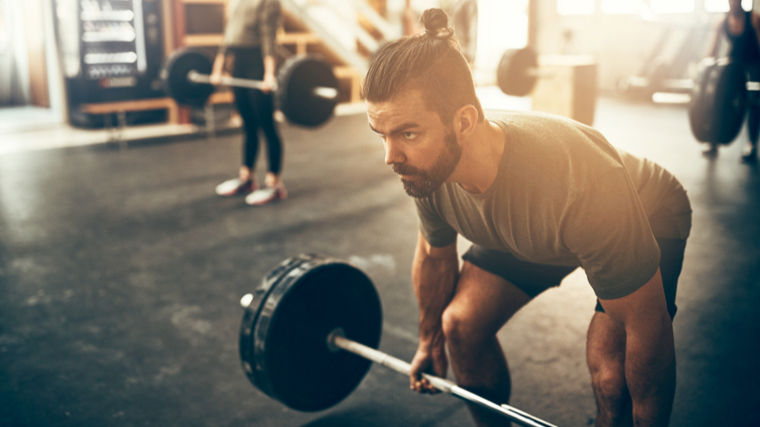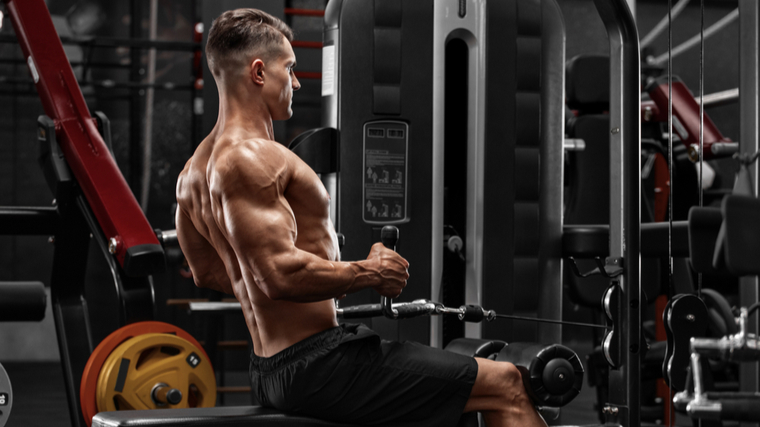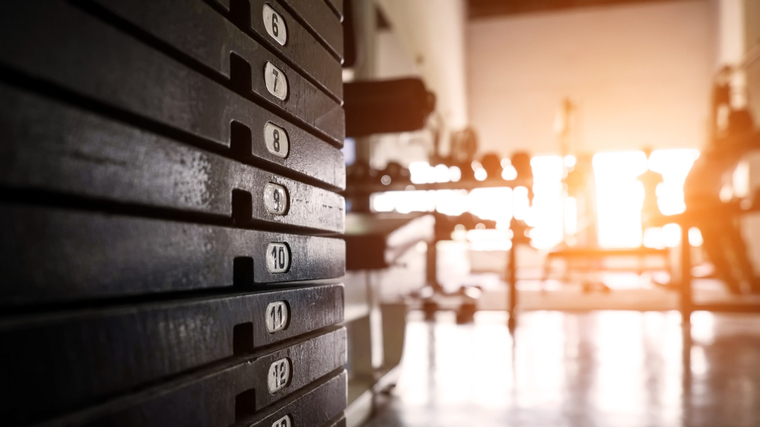Working out properly can be hard. While some people set foot in the gym and go straight to the bench or bang out endless sets of dumbbell curls, most truly accomplished lifters rely on the right program to be their vessel for progression.
Adding structure to your workouts is one of the best ways to make progress. Two of the most popular ways of organizing your approach to the gym are adopting either a full-body workout routine or taking up a body part split.

[Related: Home Gym Essentials]
These two workout split formats are popular because they’re versatile, easy to understand, and can be implemented in a wide variety of training environments to suit almost any goal. With that said, you probably want to know which of the two splits is right for you.
Differences Between Full Body and Split Workouts
The aim of lifting weights is to improve size, strength, or athletic ability with respect to a certain goal. Both full-body and split workouts come with advantages and drawbacks, so understanding how they are different can help you in your decision-making process.
Training Frequency
The training frequency of full-body workouts is likely going to be lower than when splitting the body into segments. The goal of full-body workouts is to train as many muscle groups as possible within a single workout. This means that there will be a significant overlap of muscles trained during each session and thus longer periods of recovery to safely see progress.
On the other hand, body part split workouts may call for a training frequency of up to five to six days per week, because of the ability to isolate certain muscle groups while letting your tired muscles reover.
Exercise Selection
To efficiently utilize training time, full-body workouts tend to prioritize barbell and dumbbell variations of exercises such as squats, hinges, presses, rows, and lunges. However, body part split workouts allow the lifter to focus on a select muscle or muscle group each day.
This allows for greater individuality and variation between workouts in a given week because of significantly less muscle-group overlap between sessions. Machines, cables, and bands are all common training tools in body part splits in addition to the more traditional barbell and dumbbell exercises.
Similarities Between Full-Body and Split Workouts
While your workout frequency or exercise selection may be different when choosing between full-body or split workouts, certain training principles remain true and must be accounted for regardless of which style is chosen.
Progressive Overload
Progressive overload is a fitness principle that requires the body to incur a greater challenge than it has previously to adapt or change. In the resistance training realm, this means that the number of exercises, sets, repetitions, load, or rest periods is manipulated in some fashion to produce a greater challenge to the body over time.
For example, increasing weekly load in the squat during full-body workouts or increased repetitions per exercise in body part split workouts are methods of progressive overload. Regardless of your training style, you must push your limits in the gym over time to see true progress.
Specificity
Specificity is a training principle that states that the body will adapt to the specific challenge provided to it. For training to make meaningful progress towards a goal, regardless of program, your chosen training parameters must align with your goal. If the goal is to put on new muscle, how you train should support that. If you want to deadlift heavier, you need to work with heavier weights and lower reps.
How to Structure Full Body Workouts
Full-body workouts lend to increased frequency of training with high return-on-investment exercises, usually with a barbell. Additionally, since you’re practicing many of the same moves multiple times per week, your athletic performance with the bar tends to rapidly increase.
Although barbell-centric workouts are common, they are not the only type of full-body workout that can be effective. Unilateral exercises, calisthenics, or kettlebells are examples of other tools that are worth exploring. As long as your exercises stimulate most major muscle groups, you’re good to go.
Barbell Full Body Workout
- Barbell Squat: 3 x 6
- Barbell Romanian Deadlift: 3 x 8
- Barbell Standing Press: 3 x 10
- Barbell Row: 3 x 8
Unilateral Full Body Workout
- Bulgarian Split Squat: 3 x 10
- Single-Arm Landmine Shoulder Press: 3 x 10 per side
- Single-Arm Dumbbell Row: 3 x 12 per side
- Single-Leg Glute Bridge: 2 x 12 per side
- Single-Arm Farmer’s Carry: 3 x 20 paces per side
Bodyweight Full Body Workout
- Push-Up: 3 x 10 – 15
- Pull-Up: 3 x 8 – 12
- Inverted Row:3 x 10 – 12
- Dips: 3 x 8 – 12
- Walking Lunge: 3 x 15 per leg
Kettlebell Full Body Workout
- Kettlebell Goblet Squat: 3 x 10
- Kettlebell Push Press: 3 x 6
- Dead-Stop Kettlebell Row: 3 x 8 per side
- Kettlebell Swing: 2 x 20
- Kettlebell Windmill: 2 x 8 – 10 per side
How to Structure Split Workouts
Split workouts afford a lot more flexibility than full-body training in terms of the tools you use to fatigue your muscles. Each muscle or muscle group can be trained between one and three times per week.
Below you can find three common ways of organizing your body into a training split — one focused on a specific body part, one dividing the body into its upper and lower portions, and a workout that focuses on push/pull.
Body Part Split
Body part splits help you zone in on one specific muscle or muscle group per workout. A full week of body part training usually requires four to six sessions per week. For example, your chest, back, shoulders, legs, and arms typically require individual workouts spread across five days of the week. A sample chest workout might look something like this:
- Barbell Bench Press: 3 x 5
- Incline Dumbbell Bench Press: 3 x 10
- Machine Chest Press: 2 x AMRAP
- Cable Pec Flye: 3 x 12
Upper / Lower
An upper/lower split allows you to dedicate time and attention to your legs, torso, and arms separately. Upper/lower workouts tend to have a good “flow” and force your body to work synergistically as a unit. Here are two examples of training days, one for each half of your body.
Upper
- Dumbbell Shoulder Press: 3 x 10
- Dumbbell Lateral Raise: 3 x 15
- Single-Arm Dumbbell Row: 3 x 12
- Pull-Up : 3 x as many repetitions as possible (AMRAP)
- Hammer Curl: 2 x 10
Lower
- Leg Press: 3 x 10
- Step-Up: 3 x 10 per leg
- Hamstring Curl: 3 x 12
- Leg Extension: 3 x 12
- Glute-biased Back Extension: 2 x AMRAP
Push/Pull
Similarly to an upper/lower split, you can organize your training according to the mechanical function of your muscles. Doing “push” or “pull’ centered workouts is an extremely popular training split since it allows you to work your body synergistically and also keep a high frequency.

It’s also common to dedicate a third day in your “rotation” specifically for leg workouts, such that you end up performing two rounds of three unique workouts per week to sufficiently tax your muscles. For example:
Push
- Dumbbell Bench Press: 3 x 8
- Incline Chest Press Machine: 3 x 10
- Dips: 3 x 10
- Triceps Pushdown: 3 x 12
- Single-Arm Overhead Triceps Extension: 3 x 15 per side
Pull
- Single-Arm Cable Row: 3 x 10 per side
- Wide-Grip Lat Pulldown: 3 x 12
- Straight-Arm Lat Pulldown: 3 x 12
- Alternating Dumbbell Biceps Curl: 3 x 12 per side
- Cable Biceps Curl:3 x 12 per side
Legs
- Leg Press: 3 x 10
- Dumbbell Romanian Deadlift: 3 x 12 per side
- Bulgarian Split Squat: 3 x 12 per side
- Leg Extension: 3 x 12
- Hamstring Curl: 3 x 12
The Right Warm-Up
The differences in how you train on a body part split or a full-body routine are reflected in the way you should warm-up for each. While certain principles for warmups hold true no matter how you lift, your pre-training routine might look a bit different.
How to Warm Up For a Full Body Workout
When you’re working out your entire body, your entire body needs to be warmed up. To that end, a bit of light cardio is probably a good idea. After that, any light-weight circuit — ideally involving movements that mimic the lifts you’ll be performing on the day — can get blood pumping where it needs to be without tiring you out.
How to Warm Up for a Body Part Split
The logic is simple for body part warm-ups. If you’re training your chest, your pecs need to be primed for power. A bit of light cardio is fine beforehand, but you need to zone in on the joints and motor patterns that are involved in your specific session.
[Read More: Best Upper Chest Exercises for Building Muscle]
Since chest workouts involve isometric contraction at the shoulder for stability and heaps of elbow flexion, warming up your upper back with face pulls, banded pull-aparts, or rear delt flyes is sensible. For the elbows or wrists, any controlled curl movement with light weights should sufficiently prep the joint for the session.
If you want to be especially dutiful, you can throw in a few light sets of chest flyes or push-ups to pre-activate your pectorals.
Choosing Full Body vs. Split Workouts
Like everything in the field of fitness, choosing a full body or split workout depends on your goals. If your training doesn’t mesh well with your experience, time constraints, or available equipment, you could be leaving gains by the wayside.
Goals
Resistance training has been shown to be beneficial at as low of a frequency as twice per week. However, a single session of resistance training has also been shown to increase muscle protein synthesis (an essential part of gaining muscle) for 24 to 48 hours. (1)
Depending on your goal, you may benefit from lower-frequency full-body workouts or more frequent body part split workouts. To capitalize on muscle growth, more frequent training sessions with higher volumes per week for isolated muscle groups is likely more beneficial than full-body workouts (2).
If the goal is pure strength, less frequent workouts erring on the side of full-body compound exercises may be a better choice.
Training Age
Beginners are some of the best trainees because they have few bad habits to unlearn and often experience very rapid progress in strength, size, and bodily coordination. To take advantage of your susceptibility to gains, a full-body training split that focuses on skill development is a great option to set you up for long-term success.
If you’ve been in the gym for a while, you may benefit from either full body or split training. If you’re a powerlifter or Olympic lifter who works with the barbell, full-body training is probably up your alley as the competition lifts for your sport tend to involve every muscle in your body.
Conversely, recreational or competitive bodybuilders who want to pack on mass could double-down on their targeted work via a body part split to optimize their muscle growth.
Time
Unfortunately, you probably don’t have endless hours to spend in the gym each day. Workout duration is a real consideration when choosing a training style. Full-body workouts typically require a lower weekly time investment than body part training, but individual sessions may run a bit long.
On the other hand, a body part split can be relatively brief depending on the muscle you’re working. That said, body part splits necessitate more days in the gym throughout the week, which may equate to more total hours spent training.
Equipment
The equipment you have access to might just be the most important factor in determining which style of training is right for you. Regardless of your goals, if you can’t use the right tools or load up enough weight, you may find it hard to make progress.

If machines, sets of dumbbells, or cable systems are out of the equation, a more straightforward full-body regime is likely better for you. If you don’t have a barbell or can’t train heavy for another reason, you might want to consider a body part split.
The Big Picture
Training splits are a way for you to take control of your progress in the gym. By customizing your training program according to what works for your goals, lifestyle, and experience, you can ensure you’re getting the most out of your training time.
While there are contexts where a full body routine is superior to working your muscles individually or vice versa, eliminating ambiguity from your training via a proper program is a massive catalyst for future success.
References
- Kraemer, William, J., et. al (2009). American College of Sports Medicine Position Stand: Progression models in resistance training for healthy adults. Medicine & Science in Sports & Exercise, 41(3), 687-708.
- Schoenfeld, B., Ogborn, D., & Krieger, J. (2017). Dose-response relationship between weekly resistance training volume and increases in muscle mass: A systematic review and meta-analysis. Journal Of Sports Sciences, 35(11), 1073-1082.
Featured Image: Flamingo Images / Shutterstock